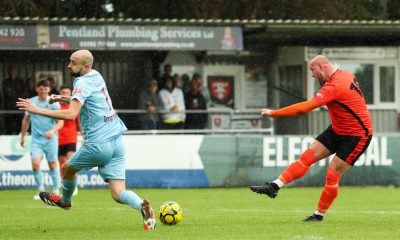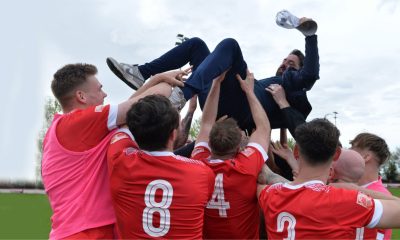
As we get closer to the FA Trophy’s showpiece final on May 17 at Wembley after today’s fifth round, Mark Stillman is looking back on the five decades of the FA Trophy. Beginning with the 1970s, each month we’ll take a walk down memory lane of Non-League’s premier cup competition…
Brian Fidler, in his own words, was a Showman. So it’s little wonder he will always remember his goal from nearly half a century ago that helped to write Macclesfield Town into the FA Trophy history books.
“I stood right on the halfway line on the right wing, all by myself,” Fidler says. “Telford were trying to equalise and had a corner. Our keeper, John Cooke, caught it and booted it to me.
“I ran forward and their goalkeeper came to the edge of the box. I chipped it over him from over 40 yards and watched it go up. And up. And up. It clipped just inside the post and rolled in.”
The Silkmen were the first ever winners of the inaugural competition that took place in the 1969-70 season, set up by the Football Association to run alongside the FA Amateur Cup.
Most leading Non-League clubs paid their players as opposed to amateurs; the latter status being abolished in 1974, leading to the end of the Amateur Cup.
This bolstered the FA Trophy entrants to 294, although numbers widely altered in the decade, during an era where Northern, Southern and Isthmian League clubs fought for election to the Football League.
Northern League Macclesfield Town and Southern League Telford United saw off Barnet and Chelmsford City in the first semi-finals, which were then one-legged ties played at neutral venues.
It was a great year for Town, who captured the locals’ imagination by also winning the Northern Premier League. Their semi-final win over Barnet at the Victoria Ground, home of Stoke City, saw just under 8,000 attend a cautious 1-0 win thanks to Dick Young’s strike.

HISTORIC: The 1970 programme cover
They carried on the on May 2, 1970, winning the first final 2-0 in front of 28,000 at Wembley. Dave Lyon, who passed away in December, scored the opener, before Fidler wrapped up the win in the closing stages.
Fidler had been to Wembley a few times with his father to watch England, but this was the first time he’d played at the iconic venue. The former midfielder’s celebration afterwards caused some controversy.
“I ran across to the Royal Box after and shouted, ‘Give me my medal now – it’s all over!’” Fidler says.
“No-one had done that before. The press afterwards said it wasn’t the right thing to do. I was a Showman. It was a big thing to score the winning goal at Wembley. That was my character.
“After the game, from memory, we went to see The Supremes, who had just started. We were invited guests.”
The Lilywhites made amends a year later, defeating Hillingdon 3-2 in the latter’s only final appearance.
Telford weren’t as fortunate as the decade progressed. In December 1977, under the stewardship of England World Cup final hero Geoff Hurst, they were humbled by Hednesford in the third qualifying round.
On the same afternoon, Cheltenham stunned future Southern League champions Bath City 7-1 at Whaddon Road, which remains the Romans’ record defeat in the competition.
Runcorn were the nearly men of the first ten years, losing three semi-finals. Their last in 1979 was at the hands of eventual winners Stafford Rangers, 3-2 on aggregate.
Goalkeeper Grahame Lloyd broke his leg in the first tie and was replaced in goal by forward Barry Whitbread which hindered their cause. They finally made it to Wembley in 1986.
Instead, it was Scarborough who almost made Wembley a second home in the decade, with four visits in five years, and differing fortunes in the FA Trophy.
In 1973, they edged past Wigan Athletic 2-1 in the first final to require extra-time. John Rogers’ last-gasp goal for the Latics forced an extra half hour before Malcolm Thompson popped up with a 116th minute winner.
Two years later, Scarborough were crushed 4-0 by Matlock, but recovered to win the next two finals.
Their 1977 win over Dagenham was dramatic. Terry Harris had given the Daggers the lead, and with 10 minutes left, Boro’ boss Colin Appleton brought on Jeff Barmby, father of future England midfielder Nick.
Harry A Dunn brought the Seadogs level with a penalty and Derek Abbey netted a winner, Scarborough’s third FA Trophy success in what turned out to be their last outing in Non-League’s leading competition showpiece event.
The 1980s started with a few underdogs upsetting the so-called giants, but as the decade progressed, the bigger names from the newly formed Alliance League got their act together.

SHOWPIECE: Brackley Town beating Bromley at Wembley in 2018
Trivia
The first four seasons saw the semi-finals competed over one leg at a neutral venue. It reverted to two legs in 1974 and has remained the same ever since.
* Matlock Town’s 4-0 win over Scarborough in 1975 is the joint largest margin of victory in the final. It was matched by Cambridge United’s success over Gosport Borough in 2014.
* In 1975, Tilbury beat Biggleswade Town 10-0 in the Preliminary Round before then losing to Barking
* Barking excelled in 1978-79, dishing out 7-2 and 10-2 defeats on Clacton and Chelmsford respectively in successive rounds. They were voted Non-League Team of the Year.
* In 1978, The FA moved the final to the Saturday following the FA Cup final to give it a longer build-up
FA Trophy finals in the 1970s
1969–70 Macclesfield Town 2 – 0 Telford United
1970–71 Telford United 3 – 2 Hillingdon Borough
1971–72 Stafford Rangers 3 – 0 Barnet
1972–73 Scarborough 2 – 1 Wigan Athletic (aet)
1973–74 Morecambe 2 – 1 Dartford
1974–75 Matlock Town 4 – 0 Scarborough
1975–76 Scarborough 3 – 2 Stafford Rangers (aet)
1976–77 Scarborough 2 – 1 Dagenham
1977–78 Altrincham 3 – 1 Leatherhead
1978–79 Stafford Rangers 2 – 0 Kettering Town
Make sure you get your copy of The Non-League Paper on Sunday for the latest news from across Non-League over the last seven days, including today’s action in the Buildbase-sponsored FA Trophy and FA Vase.
As well as exclusive match reports and pictures from all of Saturday’s fixtures in the Vanarama National League, the BetVictor-Sponsored Isthmian League, Southern League and Northern Premier League, the paper’s live coverage extends all the way to Steps 5 and 6.
Images courtesy of Geoff Findlow




















